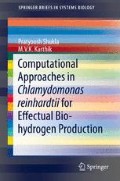Abstract
To overcome the future energy demands in times with scarcity of fossil fuel (Aleklett and Campbell 2003) new fuels have to be developed.
Access this chapter
Tax calculation will be finalised at checkout
Purchases are for personal use only
References
Aleklett K, Campbell CJ (2003) The peak and decline of world oil and gas production. Minerals Energy Raw Mater Rep 18(1):5–20
Asada Y et al (2000) Heterologous expression of clostridial hydrogenase in the cyanobacterium Synechococcus PCC7942. Biochim Biophys Acta Gene Struct Expr 1490(3):269–278
Berto P et al (2011) The cyanobacterium Synechocystis sp. PCC 6803 is able to express an active [FeFe]-hydrogenase without additional maturation proteins. Biochem Biophys Res Commun 405:678–683
Blaschkowski HP et al (1982) Routes of flavodoxin and ferredoxin reduction in Escherichia coli. Eur J Biochem 123(3):563–569
Bock A et al (2006) Maturation of hydrogenases. In: Robert KP (ed) Advances in microbial physiology. Academic, Amsterdam, pp 1–225
Borkhsenious ON, Mason CB, Moroney JV (1998) The intracellular localization of ribulose-1,5-bisphosphate carboxylase/oxygenase in Chlamydomonas reinhardtii. Plant Physiol 116:1585–1591
Bothe H et al (2010) Nitrogen fixation and hydrogen metabolism in cyanobacteria. Microbiol Mol Biol Rev 74(4):529–551
Brueggeman AJ, Gangadharaiah DS, Cserhati MF, Casero D, Weeks DP, Ladunga I (2012) Activation of the carbon concentrating mechanism by CO2 deprivation coincides with massive transcriptional restructuring in Chlamydomonas reinhardtii. Plant Cell 24:1860–1875
Casalot L, Rousset M (2001) Maturation of the [NiFe] hydrogenases. Trends Microbiol 9(5):228–237
Chueh WC et al (2010) High-flux solar-driven thermochemical dissociation of CO2 and H2O using nonstoichiometric ceria. Science 330(6012):1797–1801
Crabtree GW et al (2008) The hydrogen fuel alternative. ETATS-UNIS, Materials Research Society, Warrendale
Dent RM, Han M, Niyogi KK (2001) Functional genomics of plant photosynthesis in the fast lane using Chlamydomonas reinhardtii. Trends Plant Sci 6:364–371
Ducat DC, Way JC, Silver PA (2011) Engineering cyanobacteria to generate high-value products. Trends Biotechnol 29(2):95–103
Elowitz MB, Leibler S (2000) A synthetic oscillatory network of transcriptional regulators. Nature 403(6767):335–338
Endy D (2005) Foundations for engineering biology. Nature 438(7067):449–453
Fontecilla-Camps JC et al (2007) Structure/function relationships of [NiFe]- and [FeFe]-hydrogenases. Chem Rev 107(10):4273–4303
Fukuzawa H, Miura K, Ishizaki K, Kucho KI, Saito T, Kohinata T, Ohyama K (2001) Ccm1, a regulatory gene controlling the induction of a carbon-concentrating mechanism in Chlamydomonas reinhardtii by sensing CO2 availability. Proc Natl Acad Sci U S A 98:5347–5352
Gaffron H, Rubin J (1942) Fermentative and photochemical production of hydrogen in algae. J Gen Physiol 26(2):219–240
Gray CT, Gest H (1965) Biological formation of molecular hydrogen. Science 148(3667):186–192
Grossman AR (2000) Chlamydomonas reinhardtii and photosynthesis: genetics to genomics. Curr Opin Plant Biol 3:132–137
Harris EH (1989) The Chlamydomonas sourcebook: a comprehensive guide to biology and laboratory use. Academic Press, San Diego, 780 pp
Jacobson MZ, Colella WG, Golden DM (2005) Cleaning the air and improving health with hydrogen fuel-cell vehicles. Science 308(5730):1901–1905
Jesper Jacobsson T, Fjällström V, Edoff M, Edvinssona T (2014) Sustainable solar hydrogen production: from photoelectrochemical cells to PV-electrolyzers and back again. Energy Environ Sci 7:2056–2070. doi:10.1039/C4EE00754A
Khrebtukova I, Spreitzer RJ (1996) Elimination of the Chlamydomonas gene family that encodes the small subunit of ribulose-1,5-bisphosphate carboxylase/oxygenase. Proc Natl Acad Sci U S A 93:13689–13693
King PW et al (2006) Functional studies of [FeFe] hydrogenase maturation in an Escherichia coli biosynthetic system. J Bacteriol 188(6):2163–2172
Knight T (2003) Idempotent vector design for standard assembly of biobricks. MIT Synthetic Biology Working Group. http://hdl.handle.net/1721.1/21168
Levine RP (1968) Genetic dissection of photosynthesis. Science 162:768–771
Lindberg P et al (2002) A hydrogen-producing, hydrogenase-free mutant strain of Nostoc punctiforme ATCC 29133. Int J Hydrog Energy 27(11–12):1291–1296
Rochaix JD (1995) Chlamydomonas reinhardtii as the photosynthetic yeast. Annu Rev Genet 29:209–230
Schlapbach L (2009) Technology: hydrogen-fuelled vehicles. Nature 460(7257):809–811
Shetty R, Endy D, Knight T (2008) Engineering BioBrick vectors from BioBrick parts. J Biol Eng 2(1):1–12
te Beest M, Le Roux JJ, Richardson DM, Brysting AK, Suda J, Kubesova M, Pysek P (2012) The more the better? The role of polyploidy in facilitating plant invasions. Ann Bot 109:19–45
Vignais PM, Colbea A (2004) Molecular biology of microbial hydrogenases. Curr Issues Mol Biol 6(2):159–188
Wang Y, Spalding MH (2006) An inorganic carbon transport system responsible for acclimation specific to air levels of CO2 in Chlamydomonas reinhardtii. Proc Natl Acad Sci U S A 103:10110–10115
Wang Y, Duanmu D, Spalding MH (2011) Carbon dioxide concentrating mechanism in Chlamydomonas reinhardtii: inorganic carbon transport and CO2 recapture. Photosynth Res 109:115–122
Author information
Authors and Affiliations
Rights and permissions
Copyright information
© 2015 Springer India
About this chapter
Cite this chapter
Shukla, P., Karthik, M.V.K. (2015). Background. In: Computational Approaches in Chlamydomonas reinhardtii for Effectual Bio-hydrogen Production. SpringerBriefs in Systems Biology. Springer, New Delhi. https://doi.org/10.1007/978-81-322-2383-2_2
Download citation
DOI: https://doi.org/10.1007/978-81-322-2383-2_2
Publisher Name: Springer, New Delhi
Print ISBN: 978-81-322-2382-5
Online ISBN: 978-81-322-2383-2
eBook Packages: Biomedical and Life SciencesBiomedical and Life Sciences (R0)

